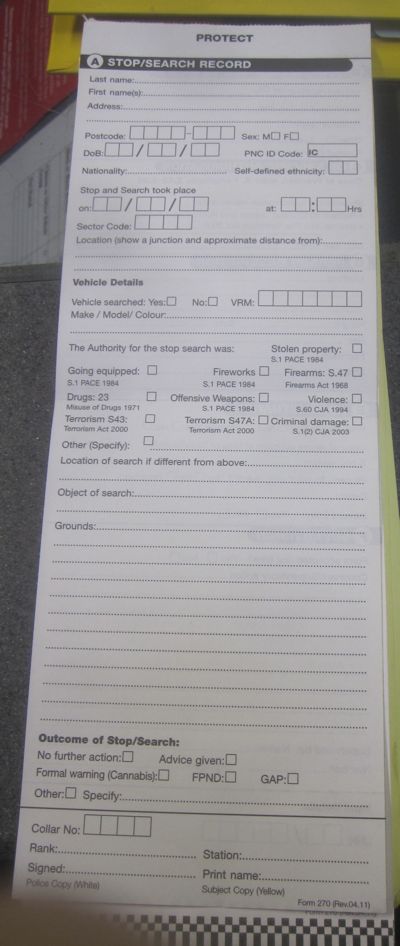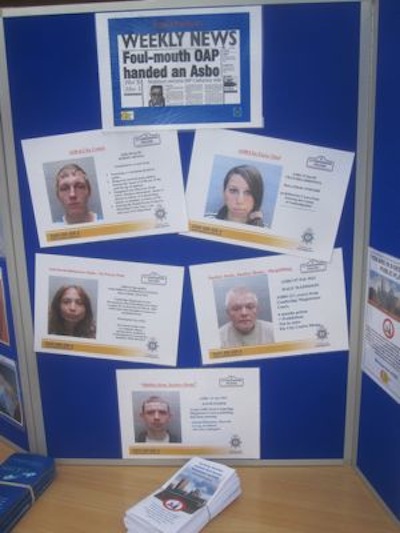
I visited Ely police station today during its open day. One reason I went was to try and find out more about the recording of stop and search in a more direct and speedy manner than is possible via Cambridge’s area committees, police authority papers, and freedom of information requests.
Last week I attended a meeting of Cambridgeshire Police Authority’s scrutiny committee where I was surprised to hear a number of authority members suggesting that the police ought change their approach to stop and search so as to ensure those from various racial and demographic groups were stopped and searched in proportion to their prevalence in the general population.
I was appalled by this as it achieving it would mean introducing race based considerations when it comes to the police deciding who to stop and search. One way the aims of the authority members could be achieved would be by ditching the PACE codes and stopping more people without grounds to balance out any disproportionality in those the police did have reason to stop and search. Alternatively once a quota for a particular race had been reached the police would not be able to stop and search any more individuals of that race. I think either of these options, or anything like them, would be terrible, both in terms of the impact on people being searched without grounds, and would damage public-police relations as those stopped would always wonder if they had been selected due to their race.
As a society we might like to see the disproportionality in the police stop and search statistics disappear; but that doesn’t mean we should achieve that by asking the police to change what they’re doing. I suspect as with so many things the real issues lie with education and our society as not being meritocratic.
I was astonished to find that not only do some members of the police authority take an opposing view to me, but a number of people commenting on my website did too. They were not happy with those describing themselves as black being twice as likely to be searched as those describing themselves as white; asserting that those statistics showed there was race based prejudice from the police in who they chose to stop and search. I argued this conclusion could not be drawn from the statistics, and that other factors could be responsible.
One thing those commenting on the statistics, including Phil Rodgers and Paul Griffiths suggested would be useful is a breakdown of “further actions” taken following a stop and search. The proportion of those searched who face further action is independent of race, I think this is a sign stop and search is being run in a race-blind manner as it indicates the police are equally likely to find what they suspect a person might have on them regardless of race.
At the Ely police station open day I spoke to Sergent McGlothlin. I asked him about the stop and search form. Initially he was, as I find the police typically tend to be, obstructive and unforthcoming, and his first instinct appeared, despite it being an “open day”, to be secretive. I think these are serious cultural problems with the police which need to be addressed and reversed. Having initially almost denied the existence of a stop and search form (he actually denied it contained any questions) and having assured me that “arrest” was one of the further actions contained on the form, he agreed to show me one.
I was able to see that the outcome options on the form were:
- No further action
- Advice given
- Formal warning (Cannabis)
- FPND (Which I presume is a Fixed Penalty Notice Disposal?)
- GAP (Which I was told was notification of a Parent or Guardian)
- Other (A free text field)

Notably “arrest” is not one of the check box options, but something which would go into the free text field. Presumably this means it would be hard to get statistics on the numbers of those stopped and searched who were eventually arrested. I think may be a more reliable statistic than the “no further action” percentage to look at to determine if the threshold for stops and searches was the same irrespective of race, given arrest is a more specific action, which officers need to be able to clearly justify. It has been suggested that perhaps conviction rates for various racial groups for crimes detected via stop and search ought be measured to ensure stop and search is being not being applied in a racially prejudicial manner. There are two problems, one is the marrying up of data from the courts with stop and search data, which isn’t as simple as considering data recorded on the stop and search form alone, the other is that by looking more broadly than at the stop and search event itsself we’re introducing even more possible variables. Looking at possible racial bias in the whole criminal justice system is a different question to looking at stop and search; we’d have to investigate, and understand, if and how the proportions of those convicted following arrest varied by racial group. I’m not saying it can’t or shouldn’t be done, just that its a broader and more systemic analysis. My view is the data available on “further action” does alone, while not ideal, give some degree of assurance there is no racial bias in Cambridgeshire Police’s use of stop and search.
I then asked Sergeant McGlothlin about the recent 115% increase in stop and search. I asked if this had come about through any change in the threshold for stopping and searching. While the increase appeared to be news to the sergeant, he said that fluctuations in the statistic did not result from changes to stop and search practice directly, but through greater targeting of specific crimes including burglary and drug use. He explained that if the police decided to do an operation which involved stopping lots of cars of youths on suspicion of being in possession of drugs; this would quickly mount up lots of stop and searches on the statistics as usually there would be lots of people in each car stopped. He also gave the example of an operation mounted in response to a spate of burglaries in an area, that too would consequentially result in more stops and searches.
While not relevant to the recent increase in stop and search in Cambridgeshire another example cited by the Sergeant was the use of designations under Section 60 of the Criminal Justice and Public Order Act 1994 which provide powers to stop and search in areas where an inspector or above anticipates violence, which don’t require any grounds for suspecting an individual is carrying weapons, can increase the number of stops and searches being carried out. (Only 33/16480 (0.2%) of the searches carried out August 2010 – July 2011 by Cambridgeshire Police were under this provision). Sergeant McGlothlin said that Section 60 was regularly invoked in Cambridgeshire and Peterborough.
Other Notes from the Open Day
- The police were proudly displaying posters of those who’d been issued with Anti-Social Behaviour orders, for example banning them from city centre shops.
- We were allowed to touch and smell cannabis which had been confiscated. The sergeant showing us the drugs said he was shocked to see the prevalence and easy availability of cannabis in the area. The bag of dried leaves were were shown we were told was worth about £300. The sergeant told us how he’d seen the negative health effects of the drug on many of those his job brought him into contact with, the paranoia, anxiety and said because of such effects he didn’t think it ought ever be legalised.
- The version of the PACE codes on the desk in the custody suite was from 2006 and did not contain any updates noting the amendments made since its publication.
- Children were being invited to assault a police officer who was dressed in riot gear. One of them managed to break the stick they were given to hit the officer with.
* Star Radio have reported that 1,100 people attended the open day. There were lots of parents with young children who were having a go in the police cars; but also many others of all ages.

3 responses to “More on Cambridgeshire Police Stop and Search from Ely Police Open Day”
Another observation is the Stop/Search form pad is not numbered. If they were numbered one could check that all forms issued on the street had been in-putted into the police computer system. As it is the system doesn’t given any assurance that is happening and that the statistics are complete.
My son was punched in Ely once when defending racial taunts against his Chinese friend and police said they were only investigating it because of the racial angle. They dropped it in the end, even though they knew the lad (a neighbour’s son). It was appalling. No justice there. They didn’t return any of my phone calls or email.
Next time you pop into Ely, ask the antique centre for their views about Ely police:
http://elleeseymour.com/2011/08/14/can-american-supercop-bill-bratton-advise-ely-police-too/